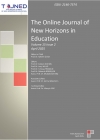TOJNED - Volume 2 - Issue 1 - January 2012
 AFFECTIVITY AND COMMUNICATION IN VIRTUAL LEARNING ENVIRONMENTS
AFFECTIVITY AND COMMUNICATION IN VIRTUAL LEARNING ENVIRONMENTS Maria de F├ā┬Ītima GOUL├āŲÆO
Abstract: If affectivity is important in classroom s learning environments, then it becomes more complex to reach in distance learning environment, where there are no other sensitive elements. The type of communication established between all members of the community is paramount to create bonds of affection. The expression of affectivity in learning environments is about communication, which in a virtual environment, is essentially made by using the writing. The way of communication becomes to be expressed in written form, where may arise some indicators which will turn into a symbolic register. This logic operation involves changes in social relations established between the elements of these communities. They write texts which are interconnected with certain symbols. There is a connection between affectivity and cognition. The rational brain and the emotional brain work as a whole, in a present context and also in a virtual context. This paper aims to address the affective dimension of learning in virtual environments, whether in Forums, whether the characteristics of the e-teacher, valued by learners. Our results, in both parts of our study, highlights the presence of the affective component and it regulator role in these learning contexts.
 THE RELATIONSHIP BETWEEN FEMALE ADOLESCENT S STRATEGY ON COMBATING WITH STRESS
THE RELATIONSHIP BETWEEN FEMALE ADOLESCENT S STRATEGY ON COMBATING WITH STRESS G├ā┬Čkmen DA├ä┼ŠLI
Abstract: The aim of this research is to investigate on the relationship between female adolescents strategy on combating with stress who have commited disciplinary crime and continuous anger-anger manner. Research population is based on students in TRNC attending vocational high schools. 102 students out of the ones who commited disciplinary crime are sampled by appropriate sampling method and included in the research. For data gathering tool, ├óŌé¼┼ōContinuous Anger-Anger Manner Scale├óŌé¼┬Ø by ├āŌĆōzer (1994) and ├óŌé¼┼ōStress Management Strategies Scale├óŌé¼┬Ø adopted by Sahin and Durak is used in the research. Continuous Anger-Anger Manner Scale in Turhish form is calculated separately for Cronbach Alpha values, dimensions for ├óŌé¼┼ōContinuous Anger├óŌé¼┬Ø, ├óŌé¼┼ōanger under control├óŌé¼┬Ø, ├óŌé¼┼ōobserved anger├óŌé¼┬Ø are found .81, .83, .79, .72, respectively. ├óŌé¼┼ōStress Management Strategies Scale├óŌé¼┬Ø Cronbach alpha trust coefficient is varying between 0.49 and 0.82. In the analysis of data SPSS (Statistical Package for the Social Science)13.0 package program is used. For data, Pearson moments multiplication, arithmetic average,single-sided variance analsis (ANOVA) and ttest is employed. Significance level is taken as 0.05 in the research. In conclusion of the research, for female adolescents who commited disciplinary crime, it has been found that there are significant relationship between Stress Managemt Strategies Scale and Anger-Anger Manner Scale. Furhermore, it has been observed that Stress Managemt Strategies Scale and Anger-Anger Manner Scale Lower Scale are significantly varying depending on sociodemographic features.
 THE EUREKA MOMENT: EMBRACING THE NEW PARADIGM OF MUSICAL SOUNDS THROUGH ALTERNATIVE PEDAGOGY AND CURRICULUM IN THE MUSIC CLASSROOM
THE EUREKA MOMENT: EMBRACING THE NEW PARADIGM OF MUSICAL SOUNDS THROUGH ALTERNATIVE PEDAGOGY AND CURRICULUM IN THE MUSIC CLASSROOM Dr. John L. Vitale
Abstract: Within seconds of opening the package to a brand new MP3 player, my 8-year-old son installed the batteries, connected his headphones and starting searching for songs. He soon realized that there was no music and said: ├óŌé¼┼ōDad, the store ripped us off, they sold us an MP3 player with no music on it.├óŌé¼┬Ø This was a Eureka moment for me when I truly realized that a major paradigm shift in music listening had transpired -- a new digital paradigm where musical sounds are expected to be ubiquitous and gratis. This principal aim of this article, therefore, is threefold: (a) to highlight the new paradigm of musical sounds rooted in the new age of digital music, (b) to contend that the new paradigm requires alternative approaches to pedagogy in the music classroom embedded in the principles of holistic and democratic education, and (c) to encourage music teachers to adopt alternative curriculum methods entrenched in the new paradigm. Prior to addressing these issues, however, a contextual and theoretical framework that explores the relationship between sound and music is provided.
 THE POLITICS OF BEAUTY
THE POLITICS OF BEAUTY Donna KAKONGE
Abstract: Transformation/In Loree s Beauty shop/hot combs sizzled/against/wet oily scalps/branding/grown woman fantasies/into tender young/heads./Thick busy afros/became/long glossy black curls/transforming/natural Black queens/into/commercial mahogany princess. (Boyd, 1997). The politics of black hair is defined as challenges to the traditional ideals of beauty that affect all of us globally. As an example of this, blonde hair and blue eyes are now globally seen as the perfection of beauty. This is evident from an examination of the media arts and entertainment industries. The politics of black hair in media arts education is a dissertation proposal for online media studies, black studies and feminist studies curriculum development designed for postsecondary education. The basis for developing the curriculum will be Donna Kakonge s graduate research on the politics of black hair called Afro Forever (1999), also known as What Happened to the Afro? (2006), done at Concordia University s Communications department back in 1999. The aim of the dissertation and online project is to broaden my scope of research from my master s thesis on the politics of black hair to a wider curriculum framework.
 ENVIRONMENTAL EDUCATION IN PORTUGUESE SCHOOL PROGRAMMES AND TEXTBOOKS IN TWO PERIODS: 1991-2000 AND 2001├óŌé¼ŌĆ£2006.
ENVIRONMENTAL EDUCATION IN PORTUGUESE SCHOOL PROGRAMMES AND TEXTBOOKS IN TWO PERIODS: 1991-2000 AND 2001├óŌé¼ŌĆ£2006. Rosa Branca TRACANA, Eduarda FERREIRA,Gra├ā┬¦a CARVALHO
Abstract: Environmental education (EE) is seen as a key instrument contributing for changing values, mentality and attitudes. This study intends to examine how EE addresses environmental education in the Portuguese school programmes in two periods, Time I: 1991/1992 ├óŌé¼ŌĆ£ 1999/2000 and Time II: 2000/2001 ├óŌé¼ŌĆ£ 2005/2006. We used the grids of analysis constructed within the BIOHEADCITIZEN project (CIT2-2004-506015). The analysis covered the national programmes and textbooks since the 1st grade (5/6 years-old pupils) up to the 12th grade (17/18 years-old pupils) by looking at the four pre-selected sub-topics: Pollution, Use of Resources, Ecosystems and Biodiversity and Cycles. Biodiversity is the sub-topic that had little presence in Time I but is nowadays (Time II) more present all along the school levels. In earlier years (1CBE) the textbooks follow the national programme very tightly. Major differences between the national programmes and the textbooks examined were found in the Secondary school (10th, 11th and 12th grade).


